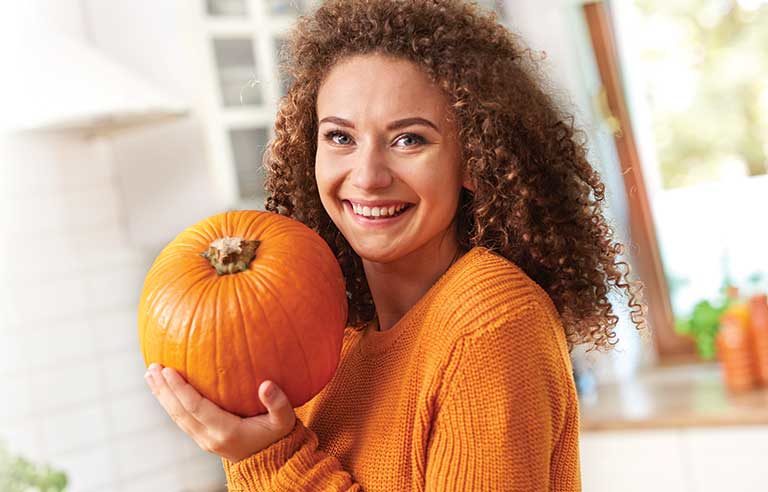7 healthy fall foods to fill your plate

Photo: gpointstudio/iStockphoto
Apple picking. Pumpkin carving. Eating Thanksgiving dinner with sweet potatoes and cranberries.
All these take center stage during fall, when these fruits and vegetables are most in season.
What do we mean by “in season”?
“A seasonal food is any produce purchased and consumed around the time it is harvested,” says Kimberly Snodgrass, a registered dietitian nutritionist and national spokesperson for the Academy of Nutrition and Dietetics.
And why should we be eating seasonal foods?
“We know that produce that is purchased in season is more likely to be fresher, consumed closer to harvesting and higher in nutritional value,” Snodgrass said.
The peak season for fall foods runs from September through November. During that time, give some of these nutrition-packed foods a go.
Apples
Apples are an excellent source of fiber, the academy tells us. In fact, one apple – with its skin – can give us about 20% of our daily recommended fiber intake. They also pack a punch when it comes to vitamin C, “an antioxidant that helps protect your cells” from heart disease and cancer, the Mayo Clinic says.
ON YOUR PLATE: Sweeten up an apple slice with ground cinnamon or some peanut butter. Make a peanut butter-apple-banana smoothie. Or, the academy suggests stewing apples and adding them to a hot dish such as roasted pork.
Brussels sprouts
“Brussels sprouts are part of the powerhouse cruciferous veggie family,” the Academy of Nutrition and Dietetics says on its website. “Each 1-cup serving of cooked brussels sprouts provides 4 grams of fiber; is an excellent source of vitamins A, C, K and folate; and a good source of iron. They even have some protein.”
ON YOUR PLATE: Roasted or air-fried Brussels sprouts are a tasty, crunchy snack. You can also shred them to make a noodle dish. Or try making vegetable kebabs with Brussels sprouts as a component. They’re also easy to chop up and add to a stir-fry.
Cranberries
More than just a side dish for Thanksgiving dinner, cranberries are a great source of vitamins C, K and E. They also can provide anti-inflammatory relief.
ON YOUR PLATE: Toss some cranberries into your salad or on top of your oatmeal. Make a homemade trail mix that uses cranberries. They also go great with hot foods such as turkey and chicken.
Grapes
Sometimes referred to as nature’s candy, grapes are a satisfying, low-calorie snack. They’re also another great source of vitamins C and K and potassium, which aids in muscle contractions and heart function. They can help keep us hydrated as well as lower our cholesterol and blood pressure.
ON YOUR PLATE: Try freezing grapes for a refreshing snack. Add them to your salad or a smoothie. They’re also a popular addition to chicken salad.
Pears
Pears are another excellent source of fiber, if you eat them with the peel on. Also look to them for vitamins C and K, potassium, and copper – which helps with immunity, lowering cholesterol and nerve function.
ON YOUR PLATE: Grill pears and add them to a chicken or turkey sandwich. Cut into slices and eat with cheese. Or, try a pear and yogurt parfait.
Pumpkin
Pumpkin is loaded with vitamin A, which helps give us healthy teeth, skin and soft tissue, as well as promotes good eyesight. It also plays a part in reducing our risk of chronic disease. However, “note that the pumpkins you carve into jack-o’-lanterns are not the same type of pumpkins you eat,” the academy says. Carving pumpkins have thinner flesh, making them easier to cut. The pumpkins we eat are heavier and tend to be darker in color.
ON YOUR PLATE: Puree some pumpkin and add it to macaroni and cheese or hummus. Make pumpkin soup. And it’s OK to roast the seeds from the pumpkins you carve, the academy adds. They’re a healthy snack and “a source of several nutrients, including zinc, which is essential for many body processes, including immune function.”
Sweet potatoes
Full of fiber, vitamins A and C, and potassium, sweet potatoes also may boost brain health and gut health. They can help stabilize the body’s blood sugar, protect against chronic diseases and help us maintain a healthy weight.
ON YOUR PLATE: Cut a sweet potato into slices, brush with olive oil and then bake the slices to make sweet potato chips. Or, use them as a substitute for regular potatoes in a mashed dish or potato salad.
Post a comment to this article
Safety+Health welcomes comments that promote respectful dialogue. Please stay on topic. Comments that contain personal attacks, profanity or abusive language – or those aggressively promoting products or services – will be removed. We reserve the right to determine which comments violate our comment policy. (Anonymous comments are welcome; merely skip the “name” field in the comment box. An email address is required but will not be included with your comment.)
